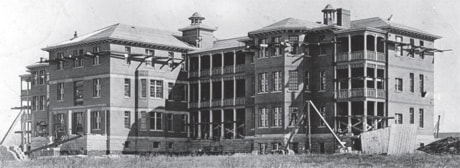That short two-kilometre trip to and from town to the Centennial Centre for Mental Health and Brain Injury has been made many thousands of times over the years along a narrow tree lined paved road that has a very colourful history.
Now let’s take a look back to when it all started with the exciting announcement in 1908 that a new mental health treatment and care centre would be built in the rolling countryside just south east of Ponoka.
Our tiny little village had just become a bustling town in 1904, and there was no doubt that the establishment of this modern provincial hospital would certainly be a resounding incentive and benefit for Ponoka and districts long into our future. As initial plans were put into place for the construction stage of this massive facility, that rough old dirt road winding its way up from town would soon become a major transportation route. Hundreds of men from throughout Alberta and afar were hired to work long hours at the site, while the tons of equipment, building materials, rock, sand and supplies required for the next few years were slowly moved by 20 to 30 teams of heavy draught horses, oxen, and early steam tractors and machinery.
J.W. O’Brien and his son, Ernie, were awarded the contract to move the extremely heavy materials and countless articles from the busy Ponoka Canadian Pacific Railway siding to the hospital site, and would be assisted by Jim Stoutenberg and an ongoing team of men. Due to the unsatisfactory nature of the subsoil, the piles for the foundations for all the buildings had to be set at a depth of 25 feet. The many tons of ‘nigger-head’ rock that would be required for the packing and to make the cement was broken down on site by more than 20 steam-driven crushers and temperamental cement mixers. One of the first steps of this construction was the drilling of a 200-foot well near the eventual powerhouse site, which has been the vital operational heart of this huge facility since its beginning on July 4, 1911. All of the unloading from the freight cars at the station was done by hand by hardy iron men, with the exception of some massive machinery units, for which a gin-pole was rigged up and the lifting done by a winch.
The initial central administrative structure (still partially standing as the Heritage Building) was a solid red brick three-storey structure, 139 feet long and 45 feet wide, with two 95 by 42 foot wings to house the patients and a basement for storage and other uses. This very modern, fireproof and aesthetically friendly initial building housed the medical, administrative, and support staff. The bright and comfortable patient wings included sleeping and workrooms, as well as large sitting rooms, outside verandas, and day areas that featured a fireplace and large bay windows.
During those hectic three plus years of construction the men involved would live in tents or bunkhouses on the grounds, while a few had the luxury of staying in one of the posh boarding houses in Ponoka. Needless to say paydays and rare days off were certainly a boom for our local shops and of course the friendly confines of the Royal Hotel and Leland pubs, while many enjoyed a dip in the Battle River or occasional fun games of baseball and hockey.
Frank Young, who worked as the powerhouse superintendent at the Provincial Mental Hospital for more than 30 years, recalled at the 50th anniversary celebration of the hospital that he drove some of those teams up and down that road as a teenager. The story explained that when the two big boilers came in for the new power plant they were carefully loaded onto two wagons that had been drawn together side by side and had heavy timbers chained across them. This extremely heavy cargo of solid steel was then slowly taken up to the hospital site under the power of Anton Bittner’s steam engine.
As the patient count at the hospital grew rapidly in those early years, more buildings, staff, services, and equipment were required in all areas of the busy grounds. A railway spurline was later added to bring in the countless supplies and equipment that were required for all departments, as well as coal, building materials, and even cattle for the new farm. Large trucks would eventually replace those reliable wagons and teams that had made so many tough trips in the early days, and when the powerhouse received new equipment in the 1960s the local trucking firm of Merle S. Gee brought them all the way here from Eastern Canada. During the 1950s to the Seventies countless truckloads of canned food and products from the farm were also shipped out from the hospital to institutions throughout Alberta.
It was certainly a magnificent feat of construction, planning, and manpower that marked the exciting beginnings of the Ponoka hospital and over the past 100 years that same keen staff dedication and skills have continued to produce outstanding milestones in care and treatment for thousands of patients. Everyone is invited to share these countless memories and celebrate the present expansion, successes, and bright future of this world class Psychiatric facility during the 100th anniversary of the Centennial Centre for Mental Health and Brain Injury Reunion Weekend July 29 to 31.
